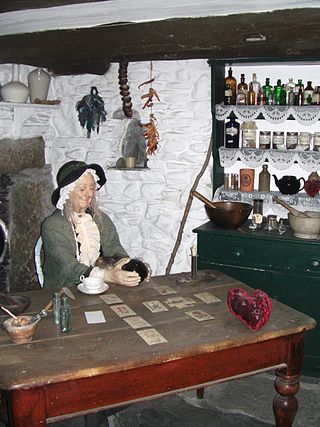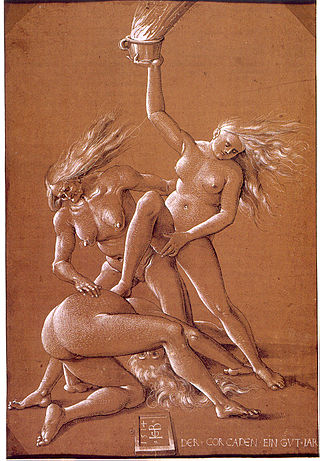Witchcraft, as most commonly understood in both historical and present-day communities, is the use of alleged supernatural powers of magic. A witch is a practitioner of witchcraft. Traditionally, "witchcraft" means the use of magic or supernatural powers to inflict harm or misfortune on others, and this remains the most common and widespread meaning. According to Encyclopedia Britannica, "Witchcraft thus defined exists more in the imagination of contemporaries than in any objective reality. Yet this stereotype has a long history and has constituted for many cultures a viable explanation of evil in the world". The belief in witchcraft has been found in a great number of societies worldwide. Anthropologists have applied the English term "witchcraft" to similar beliefs in occult practices in many different cultures, and societies that have adopted the English language have often internalised the term.

A Book of Shadows is a book containing religious text and instructions for magical rituals found within the Neopagan religion of Wicca. Since its conception, it has made its way into many pagan practices and paths. The most famous Book of Shadows was created by the pioneering Wiccan Gerald Gardner sometime in the late 1940s or early 1950s, and which he utilised first in his Bricket Wood coven and then in other covens which he founded in following decades. The Book of Shadows is also used by other Wiccan traditions, such as Alexandrian Wicca and Mohsianism, and with the rise of books teaching people how to begin following non-initiatory Wicca in the 1970s onward, the idea of the Book of Shadows was then further propagated amongst solitary practitioners unconnected to earlier, initiatory traditions.

A doll is a model typically of a human or humanoid character, often used as a toy for children. Dolls have also been used in traditional religious rituals throughout the world. Traditional dolls made of materials such as clay and wood are found in the Americas, Asia, Africa and Europe. The earliest documented dolls go back to the ancient civilizations of Egypt, Greece, and Rome. They have been made as crude, rudimentary playthings as well as elaborate art. Modern doll manufacturing has its roots in Germany, from the 15th century. With industrialization and new materials such as porcelain and plastic, dolls were increasingly mass-produced. During the 20th century, dolls became increasingly popular as collectibles.
Black magic has traditionally referred to the use of supernatural powers or magic for evil and selfish purposes.
Stregheria is a neo-pagan tradition similar to Wicca, with Italian and Italian American origins. While most practitioners consider Stregheria to be a distinct tradition from Wicca, some academics consider it to be a form of Wicca or an offshoot. Both have similar beliefs and practices. For example, Stregheria honors a pantheon centered on a Moon Goddess and a Horned God, similar to Wiccan views of divinity.

The cunning folk were professional or semi-professional practitioners of magic in Europe from the medieval period through the early 20th century. In Britain they were known by a variety of names in different regions of the country, including wise men and wise women, pellars, wizards, dyn hysbys, and sometimes white witches.

Scott Douglas Cunningham was an American writer. Cunningham is the author of several books on Wicca and various other alternative religious subjects.
Sympathetic magic, also known as imitative magic, is a type of magic based on imitation or correspondence.

Witchcraft has been present throughout the Philippines even before Spanish colonization, and is associated with indigenous Philippine folk religions. Its practice involves black magic, specifically a malevolent use of sympathetic magic. Today, practices are said to be centered in Siquijor, Cebu, Davao, Talalora, Western Samar, and Sorsogon, where many of the country's faith healers reside. Witchcraft also exists in many of the hinterlands, especially in Samar and Leyte; however, witchcraft is known and occurs anywhere in the country.
A witch's ladder is a practice, in folk magic or witchcraft, that is made from knotted cord or hair, that normally constitutes a spell. Charms are knotted or braided with specific magical intention into the cords. The number of knots and nature of charms varies with the intended effect.

A witch bottle is a apotropaic magical item used as protection against witchcraft. They are described in historical sources from England and the United States. The earliest surviving mention is from 17th-century England.

The term Voodoo doll commonly refers to an effigy that is typically used for the insertion of pins. Such practices are found in various forms in the magical traditions of many cultures around the world.

Gary Charles Erbe, known as Raven Grimassi, was an American author of over 20 books, including topics on Wicca, Stregheria, witchcraft and neo-paganism. He popularized Stregheria, the religious practice of witchcraft with roots in Italy. Grimassi presented this material in the form of neo-paganism through his books. He had been a practitioner of witchcraft for over 45 years and was the co-director of the Ash, Birch and Willow tradition. He died of pancreatic cancer on March 10, 2019.

Laurie Cabot is an American Witchcraft high priestess, and the author of several books. She founded the Cabot Tradition of the Science of Witchcraft and the Witches' League for Public Awareness to defend the civil rights of witches everywhere. She lives in Salem, where she owned a shop. Cabot claims to be related to the prominent Boston Brahmin Cabot family.

European witchcraft is a multifaceted historical and cultural phenomenon that unfolded over centuries, leaving a mark on the continent's social, religious, and legal landscapes. The roots of European witchcraft trace back to classical antiquity when concepts of magic and religion were closely related, and society closely integrated magic and supernatural beliefs. Ancient Rome, then a pagan society, had laws against harmful magic. In the Middle Ages, accusations of heresy and devil worship grew more prevalent. By the early modern period, major witch hunts began to take place, partly fueled by religious tensions, societal anxieties, and economic upheaval. Witches were often viewed as dangerous sorceresses or sorcerers in a pact with the Devil, capable of causing harm through black magic. A feminist interpretation of the witch trials is that misogynist views of women led to the association of women and malevolent witchcraft.

A kitchen witch, sometimes called a cottage witch is a homemade poppet or doll resembling a stereotypical witch or crone displayed in residential kitchens as a good luck charm and to ward off bad spirits.

Cunning folk, also known as folk healers or wise folk, were practitioners of folk medicine, helpful folk magic and divination in Europe from the Middle Ages until the 20th century. Their practices were known as the cunning craft. Their services also included thwarting witchcraft. Although some cunning folk were denounced as witches themselves, they made up a minority of those accused, and the common people generally made a distinction between the two. The name 'cunning folk' originally referred to folk-healers and magic-workers in Britain, but the name is now applied as an umbrella term for similar people in other parts of Europe.
The Witch trials in Portugal were perhaps the fewest in all of Europe. Similar to the Spanish Inquisition in neighboring Spain, the Portuguese Inquisition preferred to focus on the persecution of heresy and did not consider witchcraft to be a priority. In contrast to the Spanish Inquisition, however, the Portuguese Inquisition was much more efficient in preventing secular courts from conducting witch trials, and therefore almost managed to keep Portugal free from witch trials. Only seven people are known to have been executed for sorcery in Portugal.
Voodoo in popular culture encompasses various representations of practices associated with different forms of voodoo, including Haitian Vodou and Louisiana Voodoo, and other elements attributed to African diaspora religions, with such representations often deviating substantially from any actual voodoo practices or beliefs. Tropes regarding voodoo appear most often in supernatural fantasy or horror films, with common themes including the activity of witch doctors, the summoning or control of dark spirits, use of voodoo dolls to inflict pain on people remotely, and the creation of zombies.
Kate West is a British author and Wiccan High Priestess. West has held influential positions within the Pagan Federation and the Children of Artemis and has led her own coven, the Hearth of Hecate, since the 1990s. She has written thirteen books and is considered the most successful British author on witchcraft.











